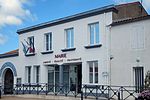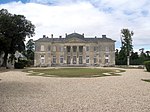Aytré
Charente-Maritime geography stubsCommunes of Charente-Maritime

Aytré (French pronunciation: [ɛtʁe]) is a commune in the Charente-Maritime department, Nouvelle-Aquitaine, southwestern France. Aytré is especially known for its long beach, which is easily accessible from neighbouring La Rochelle, or Les Minimes. The beach is flat and shallow, making it a good bathing spot for children, and an excellent spot for windsurfing. The historian Jean Prasteau (1921–1997) was born in Aytré, as was Jean Desaguliers, a Protestant pastor, and father of John Theophilus Desaguliers.
Excerpt from the Wikipedia article Aytré (License: CC BY-SA 3.0, Authors, Images).Aytré
Rue Henri Barbusse, La Rochelle
Geographical coordinates (GPS) Address Nearby Places Show on map
Geographical coordinates (GPS)
| Latitude | Longitude |
|---|---|
| N 46.1347 ° | E -1.1133 ° |
Address
Église Saint-Étienne
Rue Henri Barbusse
17440 La Rochelle
Nouvelle-Aquitaine, France
Open on Google Maps










